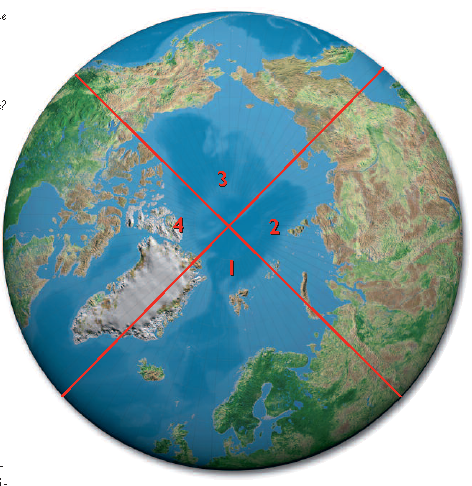Introduction to the Arctic Climate Impact Assessment
Published: February 9, 2010, 2:40 pm
Updated: May 7, 2012, 4:55 pm
Author: International Arctic Science Committee
This is Chapter 1 of the Arctic Climate Impact Assessment
Authors: Henry Huntington, Gunter Weller. Contributing Authors: Elizabeth Bush,Terry V. Callaghan,Vladimir M. Kattsov, Mark Nuttall
I have heard it said by many Russians that their climate also is ameliorating! Will God, then, ... give them up even the sky and the breeze of the South? Shall we see Athens in Lapland, Rome at Moscow, the riches of the Thames in the Gulf of Finland, and the history of nations reduced to a question of latitude and longitude? Astolphe de Custine, 14 July 1839[1]
The Arctic Climate Impact Assessment(ACIA) is the first comprehensive, integrated assessment of climate change and ultraviolet (UV) radiation across the entire Arctic region.The assessment had three main objectives:
- To provide a comprehensive and authoritative scientific synthesis of available information about observed and projected changes in climate and UV radiation and the impacts of those changes on ecosystems and human activities in the Arctic. The synthesis also reviews gaps in knowledge and the research required to fill those gaps.The intended audience is the international scientific community, including researchers and directors of research programs.The ACIA Scientific Report fulfills this goal.
- To provide an accessible summary of the scientific findings, written in plain language but conveying the key points of the scientific synthesis.This summary, the ACIA Overview Report[2], is for policy makers and the general public.
- To provide policy guidance to the Arctic Council to help guide the individual and collective responses of the Arctic countries to the challenges posed by climate change and UV radiation.The ACIA Policy Document[3] accomplishes this task.
An assessment of expected impacts is a difficult and long-term undertaking.The conclusions presented here, while as complete as present information allows, are only a step – although an essential first step – in a continuing process of integrated assessment[4].There are many uncertainties, including the occurrence of climate regime shifts, such as possible cooling and extreme events, both of which are difficult if not impossible to predict. New data will continue to be gathered from a wide range of approaches, however, and models will be refined such that a better understanding of the complex processes, interactions, and feedbacks that comprise climate and its impacts will undoubtedly develop over time. As understanding improves it will be possible to predict with increasing confidence what the expected impacts are likely to be in the Arctic.
This assessment uses the definition of the Arctic established by the Arctic Monitoring and Assessment Programme, one of the Arctic Council working groups responsible for the ACIA. Each of the eight arctic countries established the boundary in its own territory, and the international marine boundary was established by consensus. The definition of the arctic landmass used here is wider than that often used but has the advantage of being inclusive of landscapes and vegetation from northern forests to polar deserts, reflecting too the connections between the Arctic and more southerly regions. Physical, biological, and societal conditions vary greatly across the Arctic. Changes in climate and UV radiation are also likely to vary regionally, contributing to different impacts and responses at a variety of spatial scales.To strike a balance between overgeneralization and over-specialization, four major regions were identified based on differences in largescale weather- and climate-shaping factors.Throughout the assessment, differences in climate trends, impacts, and responses were considered across these four regions, to explore the variations anticipated and to illustrate the need for responses targeted to regional and local conditions. The four ACIA regions are shown in Fig. 1.1.There are many definitions of the Arctic, such as the Arctic Circle, treeline, climatic boundaries, and the zone of continuous permafrost on land and sea ice extent on the ocean.The numerous and complex connections between the Arctic and lower latitudes make any strict definition nearly meaningless, particularly in an assessment covering as many topics and issues as this one. Consequently, there was a deliberate decision not to define the Arctic for the assessment as a whole. Each chapter of this report describes the area that is relevant to its particular subject, implicitly or explicitly determining its own southern boundary.
Chapter 1: Introduction to the ACIA (Introduction to the Arctic Climate Impact Assessment)
1.1 An Introduction to the Arctic Climate Impact Assessment]
1.2. Why assess the impacts of changes in climate and UV radiation in the Arctic?
1.3. The Arctic Climate Impact Assessment
1.4. The assessment process
1.5. The Arctic: geography, climate, ecology, and people
1.6. An outline of the assessment
References
Citation
Committee, I. (2012). Introduction to the Arctic Climate Impact Assessment. Retrieved from http://editors.eol.org/eoearth/wiki/Introduction_to_the_Arctic_Climate_Impact_Assessment- ↑ Quote from de Custine, A., 2002. Letters from Russia. New York Review Books, xiii + 654pp.
- ↑ ACIA, 2004a. Impacts of a Warming Arctic: Arctic Climate Impact Assessment. Cambridge University Press.
- ↑ ACIA, 2004b. Arctic Climate Impact Assessment. Policy Document. Issued by the Fourth Arctic Council Ministerial Meeting, Reykjavík, 245 November 2004. At www.amap.no/acia.
- ↑ e.g. Janssen, M., 1998. Modelling Global Changes.The Art of Integrated Assessment Modelling. Edward Elgar Publishing. 262pp.
